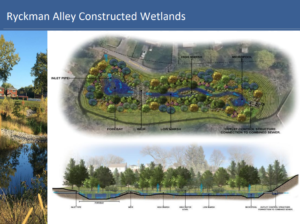Collaborative approaches improve cost-effectiveness, the health of our residents, and the environment. There are a number of goals and benefits that derive from collaborative approaches, according to CDM Smith Vice President and Senior Infrastructure Planner Bill Cesanek at the Nov. 12 “Planning and Utilities, Cities and CSOs—The Value of Collaboration to Improve Municipalities” workshop. Through his work for different city departments across the country, Cesanek observed the residual effects of siloing in cities and differentiation of functions by department. As a result, CDM Smith is attempting to build an integrative, long-term, watershed-based approach to achieve compliance with the Combined Sewer Overflow (CSO) Long Term Control Plans (LTCPs).
Municipal planners, drinking water/sewer utility officials, municipal development officials, CSO permittees, consultants, and interested parties gathered for the virtual workshop that was co-hosted by Jersey Water Works and the New Jersey Chapter of the American Planning Association. The workshop was designed to help planners and officials understand the ways in which they can reduce sewage generation through water conservation and redevelopment design, including stormwater systems retrofits and green infrastructure. It also covered the use of public spaces in ways that help resolve CSOs while reducing customer costs and improving the quality of life and resilience of CSO neighborhoods and municipalities.
Director of Water Quality Programs Martin Daley and Water Supply Deputy Commissioner William Simcoe— both from the City of Albany Department of Water—presented the City of Albany as a case study of a coordinated approach. Daley explained that there are 92 outfalls among the six Albany Pool communities. Due to the significant amount of CSO volume discharged by these communities into the same water body, the communities partnered to develop one single LTCP. In order to prepare the LTCP, the communities executed an intermunicipal agreement (IMA) that allocated a cost share among them based on their contributing flows into the Hudson River. The IMA acted as an outline for the communities’ roles and responsibilities, binding the communities together to implement one LTCP that contained projects in each of the six municipalities. “We recognize by working together, we could [not only] share the cost of the program, but also the fruits of the labor,” Daley said. One of the projects Albany Water Board has undertaken is the construction of wetlands in Woodlawn Park. The constructed wetlands help address the flooding problem and the mitigation of CSO flows in Ryckman Alley.

“Redevelopment incentivizes the development of vacant or contaminated sites, provides opportunities for public-private partnerships, and can result in community benefits,” said City of Jersey City Environmental Planner Lindsey Sigmund. Sigmund used the Bayfront redevelopment area as an active example. Through capping the contaminated soil, the land was raised out of the floodplain. Jersey City Municipal Utilities Authority is collaborating with the City of Jersey City on the utility buildout. They plan to include a sewer main to capture runoff from Route 440, which is adjacent to the site. The development of the site would entail the construction of a new street grid, open space, waterfront walkway, parks, and utilities, including stormwater detention.
The virtual tour of Phoenix Park given by Moonshot Missions Managing Director and US Water Alliance Senior Fellow Andy Kricun and former Camden County Municipal Utilities Authority (CCMUA) Chief Accountant Doug Burns also demonstrated the many benefits of redevelopment. The CCMUA transformed an abandoned industrial property into a public space for the community featuring new green infrastructure. Kricun described the project as “a triple win”—the main benefits included waterfront access for the community, reduced combined sewage flooding and improved water quality in the Delaware, and protected public health as a result of the capping of contaminated soil from the abandoned factory.
The common message from each speaker was that collaboration is key. Collaboration among different departments, agencies, and community members is vital to solving the CSO/stormwater problem in a way that enhances community value. The lessons learned from the workshop can be used in the upcoming implementation of the CSO LTCPs from the New Jersey Department of Environmental Protection.
